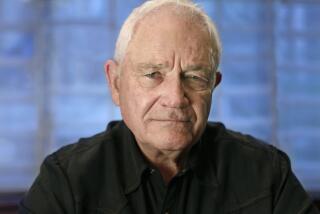Ken Annakin dies at 94; British director of ‘Swiss Family Robinson’ and others
Ken Annakin, a British director whose films included the family-adventure classic “Swiss Family Robinson,” the madcap comedy “Those Magnificent Men in Their Flying Machines” and the World War II epic “The Longest Day,” has died. He was 94.
Annakin, who suffered a heart attack and a stroke within a day of each other in February, died Wednesday at his home in Beverly Hills, said his daughter, Deborah Annakin Peters.
His five-decade career was launched in England in the early 1940s when he began making wartime documentaries. He made his feature-film directorial debut in 1947 and became what fellow British director Mike Leigh described as a “truly great master of successful, commercial cinema.”
Annakin directed nearly 50 movies, including “Across the Bridge,” “Battle of the Bulge,” “The Biggest Bundle of Them All,” “Paper Tiger,” a 1972 version of “The Call of the Wild,” “The Fifth Musketeer” and “The New Adventures of Pippi Longstocking.”
In 1966, Annakin and co-writer Jack Davies shared an Oscar nomination for their original screenplay for “Those Magnificent Men in Their Flying Machines,” a comedy depicting a 1910 London-to-Paris airplane race.
On producer Darryl F. Zanuck’s epic 1962 D-day drama “The Longest Day,” Annakin was one of three credited directors. He directed the British exterior episodes, as well as uncredited French episodes and American interior scenes.
Annakin also was known for his association with Walt Disney. Beginning with “The Story of Robin Hood and His Merrie Men” in 1952, he directed “The Sword and the Rose” (1953), “Third Man on the Mountain” (1959) and one of the Disney studio’s biggest live-action hits of the era: “Swiss Family Robinson” (1960).
“He was a wonderful director who directed all kinds of different, wonderful pictures,” said longtime friend James MacArthur, one of the stars of “Swiss Family Robinson” who also played the young lead in “Third Man on the Mountain” and appeared in the star-studded “Battle of the Bulge.”
As a director, MacArthur said, Annakin “was a general, which a director has to be, but he was a man of great intelligence and a very warm soul. But he knew what he wanted, and he was going to get it.”
Whether it was working with tigers, elephants and snakes on the island of Tobago for “Swiss Family Robinson,” shooting in a crevice in the mountains of Switzerland for “Third Man on the Mountain” or directing dozens of tanks in the snowy mountains of Spain for “Battle of the Bulge,” MacArthur said, “He just got it done.
“This was his spirit.”
Robert Wagner, one of the stars of Annakin’s 1968 crime comedy “The Biggest Bundle of Them All,” said his longtime friend “just loved the movies, and he brought so much enthusiasm to it.”
“He was just very adventurous,” Wagner said. “He had a tremendous curiosity; and up until the end of his life, he was still involved with the intrigue and the romance of making movies.”
Annakin was born in Beverley, Yorkshire, in England, on Aug. 10, 1914.
In the foreword to Annakin’s 2001 autobiography “So You Wanna Be a Director?” Leigh recounted that Annakin was a “trainee income tax inspector” in the city of Hull during the Depression.
“Then, just like the hero of a Ken Annakin movie, he won a hundred pounds on the Derby and escaped to a life of danger and adventure in New Zealand, Australia and, ultimately, the United States.
“He bummed, laboured, cycled everywhere, worked as a car salesman, compered [emceed] a commercial road show, became a journalist and even prospected for gold.
“Then, out of the chaos of the war, he entered the film industry.”
His entry into films came after he joined the Royal Air Force as a flight mechanic and was released from service when he was injured during the German bombing of Liverpool.
He began as a camera operator on training films for the RAF and documentaries for the Ministry of Information, the British Council and the Army but soon became an assistant director and then a director.
Annakin made his feature film directorial debut with the British hit “Holiday Camp,” a 1947 comedy about the working-class Huggett family, which was followed by a number of Annakin-directed sequels.
He also had a hit with “Miranda,” a 1948 fantasy-comedy starring Glynis Johns, and was known for directing segments of the multistory films “Quartet” (1948) and “Trio” (1950), which were based on W. Somerset Maugham short stories.
Contrary to previous reports that George Lucas named the “Star Wars” character Anakin Skywalker (Darth Vader) after Annakin, Lucas said via his publicist Thursday that he did not.
Annakin, who had lived in the Los Angeles area since 1979, was awarded an Order of the British Empire for his contributions to the British film industry in 2002.
Annakin’s daughter from a previous marriage, talent agent Jane Annakin, died of cancer in 1998.
In addition to his daughter Deborah, he is survived by his wife of 50 years, Pauline; two grandchildren; and two great-grandchildren.
Services will be held at 3 p.m. Monday at Westwood Presbyterian Church, 10822 Wilshire Blvd., Los Angeles.
More to Read
Start your day right
Sign up for Essential California for the L.A. Times biggest news, features and recommendations in your inbox six days a week.
You may occasionally receive promotional content from the Los Angeles Times.






